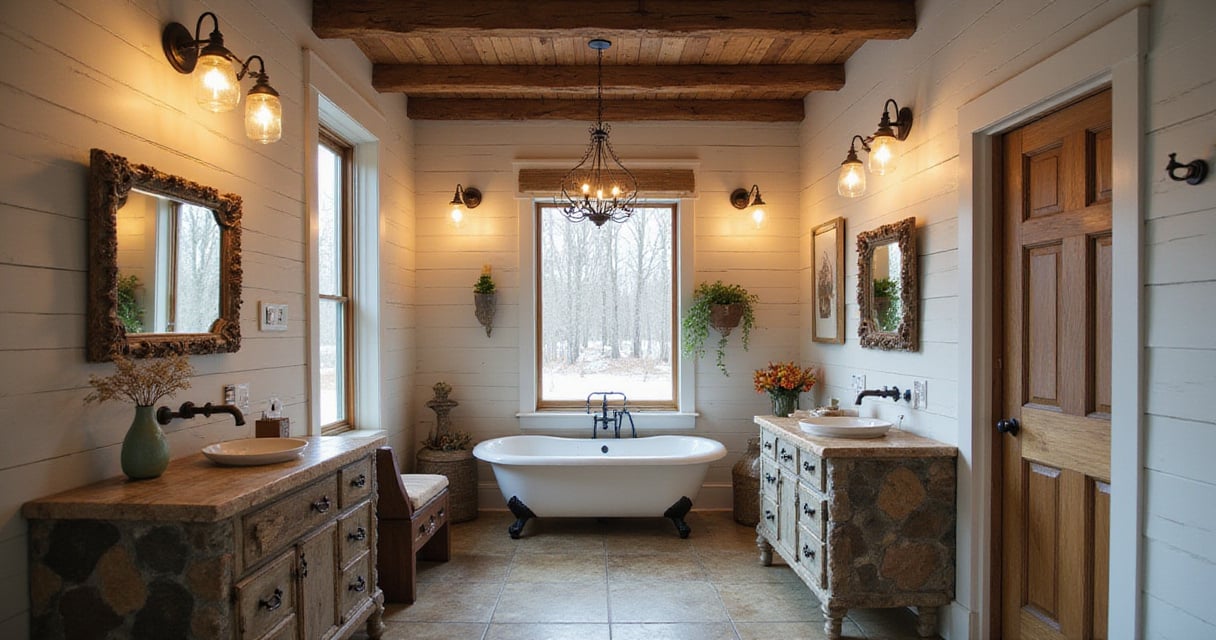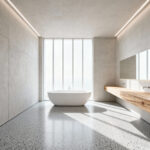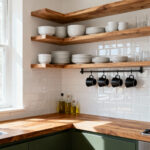Imagine stepping into a bathroom that feels like a warm embrace after a long day—where weathered wood whispers stories of craftsmanship, natural stone grounds you in earth’s timeless beauty, and every fixture reflects the authentic soul of rustic design. A rustic bathroom remodel offers far more than aesthetic transformation; it creates a deeply personal sanctuary that celebrates the marriage of function and natural beauty, turning daily routines into moments of peaceful retreat.
The magnetic pull of rustic design lies in its celebration of imperfection, its reverence for natural materials, and its ability to make spaces feel lived-in yet refined. Unlike fleeting trends that quickly lose their appeal, a thoughtfully executed rustic bathroom remodel provides enduring charm that grows more beautiful with age. From the rich patina of reclaimed barn wood to the organic textures of river stone, these elements create an atmosphere that feels both grounding and inspiring.
Whether you’re drawn to the clean lines of modern farmhouse style, the rugged warmth of mountain lodge aesthetics, or the raw sophistication of industrial rustic design, the following 18 expert ideas will guide you through creating a bathroom that truly reflects your vision. Each strategy has been carefully selected to help you navigate the unique challenges of combining rustic charm with the practical demands of a high-moisture environment, ensuring your investment remains beautiful and functional for decades to come.
1. Define Your Rustic Vision: Choose Between Farmhouse, Cabin, or Industrial Styles
The foundation of any successful rustic bathroom remodel begins with crystallizing your aesthetic vision. Rustic design encompasses three distinct personalities: Farmhouse rustic celebrates clean lines, shiplap walls, and vintage-inspired fixtures in crisp whites and warm neutrals; Cabin rustic embraces darker woods, natural stone, and cozy textures that evoke mountain retreats; while Industrial rustic combines raw materials like exposed brick and metal with weathered wood for an urban loft feel. This decision becomes your North Star, guiding every subsequent choice from tile selection to hardware finishes.
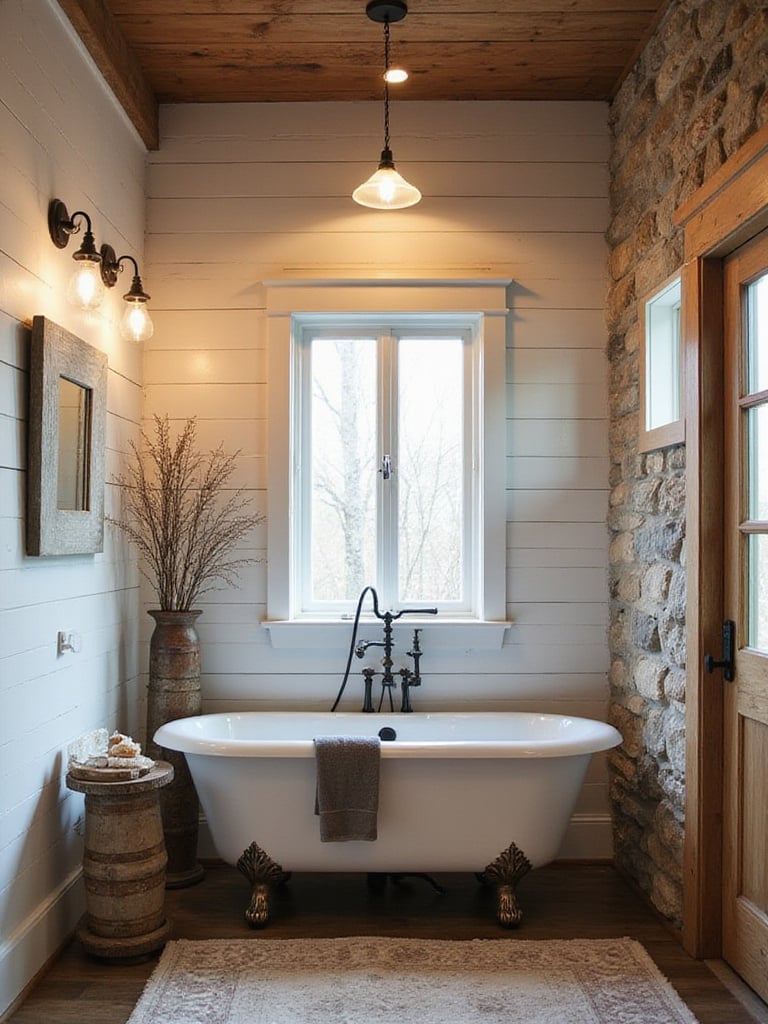
Without this clarity, your project risks becoming a collection of beautiful but disconnected elements rather than a cohesive retreat. Research shows that homeowners who define their style before shopping report 40% fewer design regrets and complete their projects 25% faster. Create mood boards for each style, noting recurring color palettes, textures, and signature elements. Consider your home’s existing architecture—a Victorian cottage might naturally lean toward Farmhouse rustic, while a contemporary home could embrace Industrial elements more seamlessly.
The beauty of this foundational step lies in how it simplifies decision-making throughout your project, ensuring every element contributes to your unified vision.
2. Establish a Realistic Budget with Contingency Planning
Once your aesthetic direction is clear, establishing a comprehensive budget becomes the cornerstone of your rustic bathroom remodel success. Beyond the obvious costs of materials and labor, rustic renovations often involve specialty items like reclaimed wood, custom metalwork, or unique vintage fixtures that can significantly impact your bottom line. A well-planned budget should account for 30-40% labor costs, 40-50% materials, and crucially, a 20% contingency fund for unexpected discoveries common in older homes.
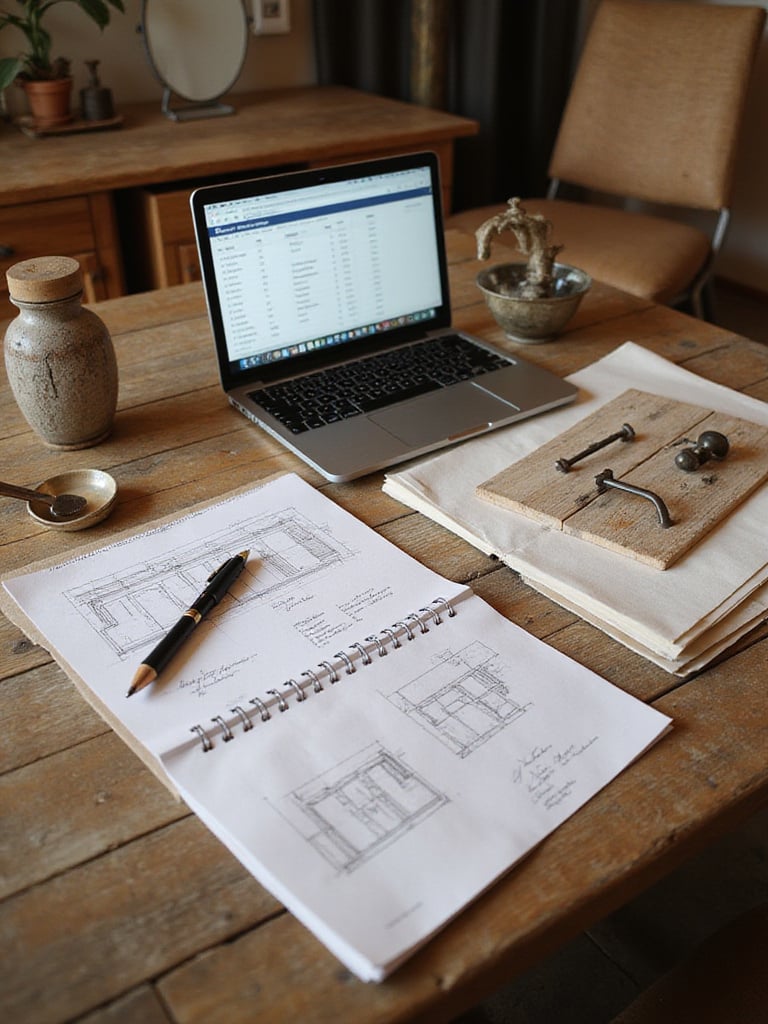
Research indicates that bathroom remodels with defined budgets and adequate contingencies experience 60% fewer project delays and financial stress. Start by gathering multiple quotes from contractors experienced with rustic materials, as working with reclaimed wood or natural stone requires specialized knowledge. Consider the long-term value of investing in quality materials—properly sealed reclaimed wood and natural stone can last decades longer than budget alternatives, making them cost-effective choices despite higher upfront costs.
- Track every expense against your budget using apps or spreadsheets
- Prioritize spending on permanent fixtures over easily changeable decor
- Research material costs for specialty rustic elements early in planning
- Factor in permits and potential structural modifications
With your financial framework established, you’re ready to dive into the exciting world of material selection.
3. Select Authentic Materials: Reclaimed Wood, Natural Stone, and Metal Accents
The soul of any rustic bathroom remodel lives in its materials, where reclaimed wood, natural stone, and carefully chosen metal accents create the foundation of authentic charm. These aren’t merely decorative choices—they’re the elements that transform a standard bathroom into a retreat that feels connected to nature and history. Reclaimed barn wood brings warmth and character impossible to replicate with new materials, while natural stone like slate or travertine provides grounding earthiness and exceptional durability in high-moisture environments.
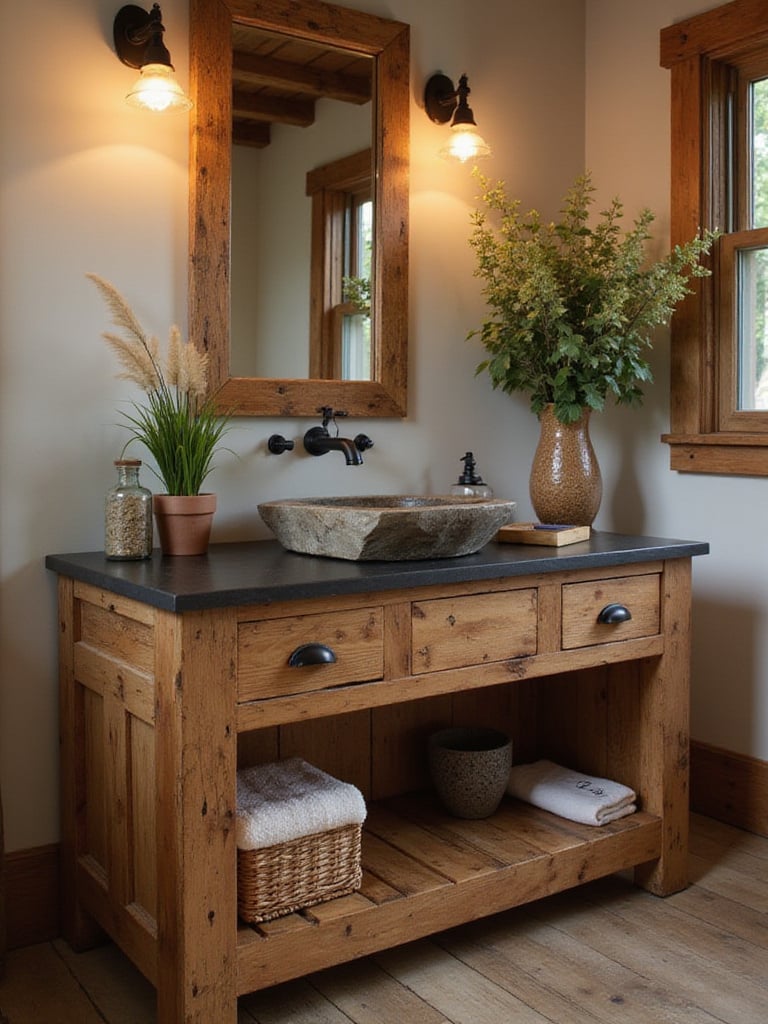
The environmental benefits of choosing reclaimed materials extend beyond aesthetics, reducing your project’s carbon footprint by up to 75% compared to new lumber while supporting sustainable building practices. When selecting these materials, prioritize proper sealing and moisture protection—reclaimed wood requires marine-grade finishes, while natural stone needs penetrating sealers applied every 2-3 years. Metal accents in oil-rubbed bronze or matte black provide the perfect counterpoint to organic textures, adding industrial touches that prevent the space from feeling too rustic or dated.
- Source materials from reputable suppliers who can verify wood treatment and stone quality
- Test finishes on sample pieces to ensure compatibility with bathroom humidity
- Plan for weight considerations, especially with natural stone installations
- Coordinate metal finishes across all fixtures for cohesive design
The magic happens when you pair a rough-hewn reclaimed wood vanity with smooth river rock and sleek matte black fixtures, creating textural layers that invite both visual and tactile exploration.
4. Create a Statement Vanity Using Reclaimed Wood
Your vanity serves as the bathroom’s focal point, and in a rustic bathroom remodel, a custom reclaimed wood vanity becomes functional art that anchors the entire design. Unlike mass-produced options, reclaimed wood vanities tell stories through their natural imperfections—nail holes, weathered grain, and rich patina that speak to decades of history. These characteristics aren’t flaws to hide but features to celebrate, creating a one-of-a-kind centerpiece that elevates your bathroom from ordinary to extraordinary.
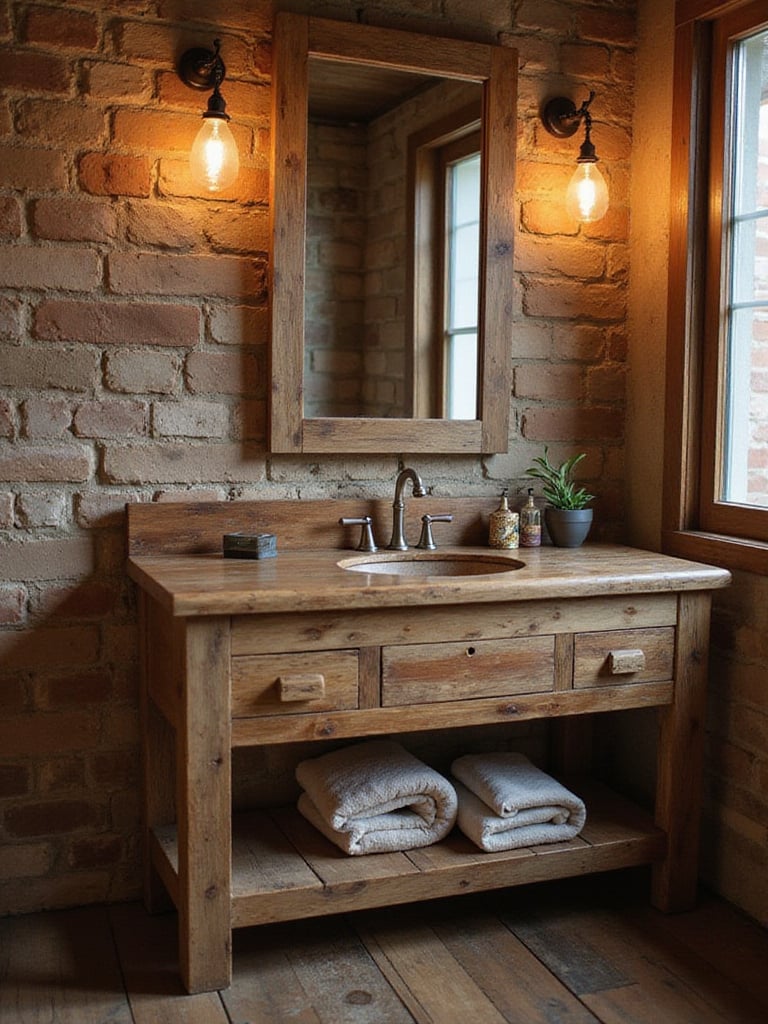
The key to success lies in proper preparation and sealing. Reclaimed wood must be thoroughly cleaned, kiln-dried to eliminate pests, and sealed with water-resistant finishes specifically designed for high-moisture environments. Work with experienced craftspeople who understand the unique properties of aged timber and can integrate modern plumbing while preserving the wood’s authentic character. Consider incorporating live edges, visible joinery, or contrasting wood species to enhance the piece’s artisanal appeal.
“The beauty of reclaimed wood lies in its imperfections—every scratch and weathered edge tells a story that new materials simply cannot replicate,” notes master woodworker James Peterson. “When properly sealed and maintained, these pieces become family heirlooms that improve with age.”
As your vanity takes shape, the next crucial decision involves selecting a sink that complements its rustic character.
5. Choose Distinctive Sinks: Copper, Stone, or Farmhouse Basins
The sink selection in your rustic bathroom remodel offers an opportunity to introduce another layer of authentic character while maintaining practical functionality. Copper vessel sinks develop beautiful patinas over time, naturally resist bacteria, and provide stunning contrast against reclaimed wood vanities. Natural stone sinks carved from single blocks of granite or river rock create organic focal points that feel like natural water basins, while classic farmhouse-style fireclay sinks offer timeless appeal with their deep basins and clean lines.
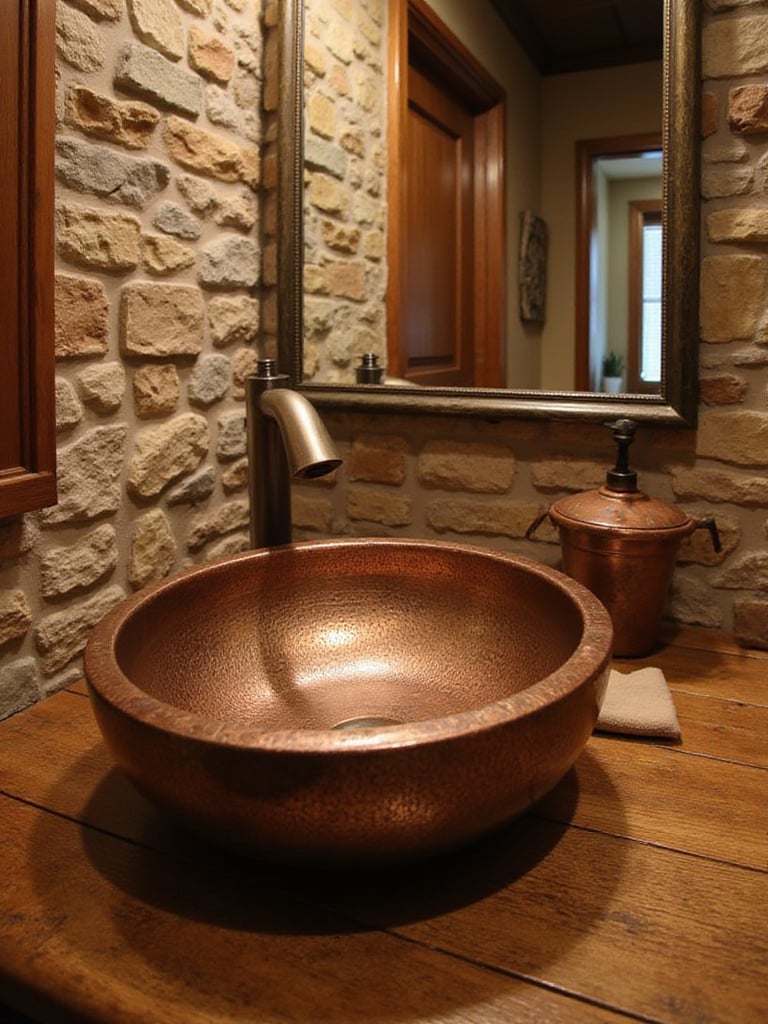
Each material brings unique maintenance considerations and aesthetic benefits. Copper sinks require periodic waxing to maintain their finish but reward owners with living surfaces that evolve beautifully over time. Stone sinks need regular sealing but offer unmatched durability and natural beauty. Farmhouse sinks provide practical deep basins perfect for daily use while maintaining authentic period charm. Consider the sink’s proportions carefully—it should feel substantial enough to anchor the vanity without overwhelming the space.
- Match sink depth to your daily usage patterns and storage needs
- Consider faucet compatibility when selecting vessel versus undermount styles
- Plan for weight requirements with stone sinks requiring reinforced cabinetry
- Research maintenance needs to ensure long-term satisfaction with your choice
The interplay between your chosen sink material and vanity wood creates the foundation for your bathroom’s character, setting the stage for flooring decisions.
6. Install Durable Wood-Look Tile or Natural Stone Flooring
Flooring in a rustic bathroom remodel must balance authentic aesthetics with practical moisture resistance, making wood-look porcelain tile and natural stone the ideal solutions. Modern wood-look tiles capture the warmth and grain patterns of real hardwood while providing superior water resistance and dimensional stability crucial in bathroom environments. Natural stone options like slate, travertine, or limestone offer unique character with their inherent variations and earthy textures that improve with age.
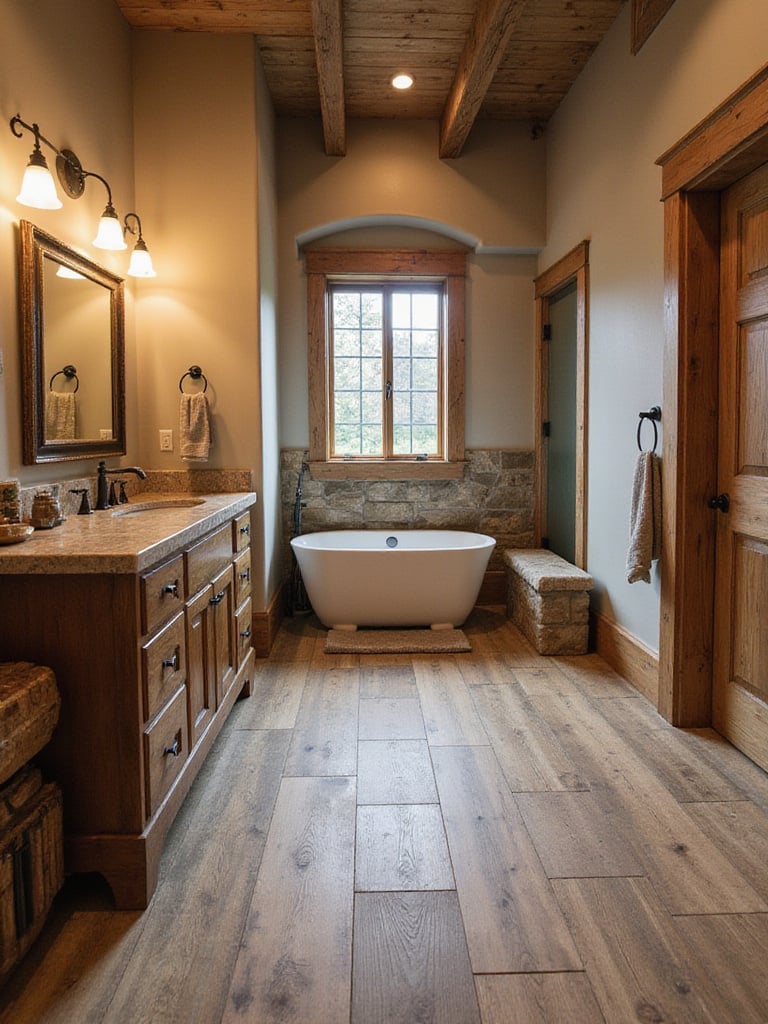
The technical aspects of installation prove critical for long-term success. Proper subfloor preparation, including moisture barriers and uncoupling membranes, prevents future failures and ensures your beautiful flooring remains stable for decades. Wood-look tiles should be installed with minimal grout lines and staggered patterns to enhance realism, while natural stone requires careful attention to lippage control and appropriate sealing. Consider incorporating radiant floor heating systems beneath your chosen flooring for added luxury and comfort during cold mornings.
Professional installation becomes especially important with these materials, as improper techniques can lead to costly failures. Research contractors with specific experience in your chosen materials, and don’t hesitate to ask for references from previous rustic bathroom projects. The investment in quality installation pays dividends in longevity and performance.
With your foundation properly established, attention turns to creating visual interest through textured wall treatments.
7. Add Textural Interest with Shiplap, Board-and-Batten, or Stone Accents
Wall treatments transform flat surfaces into dynamic elements that define your rustic bathroom remodel’s character and depth. Shiplap brings farmhouse charm with its horizontal lines and shadow gaps, while board-and-batten creates classic cottage appeal through its vertical emphasis and traditional proportions. Stone accent walls using stacked ledgestone or river rock provide organic texture and natural color variation that grounds the space in earthy authenticity.
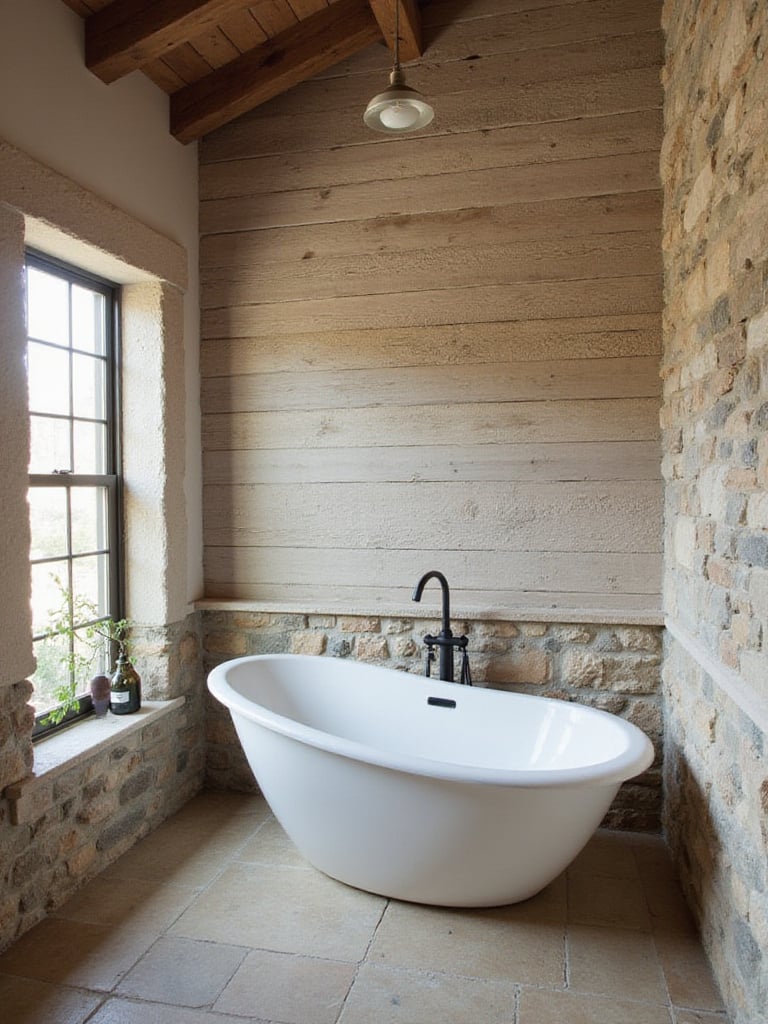
Installation techniques vary significantly between materials, with wood paneling requiring careful moisture protection and stone veneers needing proper substrate preparation and grouting. For bathroom applications, choose moisture-resistant MDF or PVC alternatives for painted finishes, or ensure real wood receives proper sealing with marine-grade products. Stone installations require experienced masons who understand proper mortar selection and sealing requirements for high-humidity environments.
- Plan electrical modifications before installation to accommodate new wall thickness
- Use moisture-resistant materials specifically rated for bathroom applications
- Consider partial coverage like wainscoting to reduce costs while maintaining impact
- Coordinate with existing fixtures to ensure proper clearances and proportions
Strategic placement proves as important as material selection—a single accent wall behind the vanity can provide dramatic impact without overwhelming smaller spaces.
Beyond the walls, your shower design offers another opportunity to reinforce the rustic aesthetic.
8. Design an Authentic Rustic Shower with Natural Materials
The shower area in your rustic bathroom remodel presents unique opportunities to incorporate natural materials while addressing practical water management needs. River rock shower floors provide exceptional slip resistance and spa-like sensory experiences, with their varied textures creating natural foot massage effects while efficiently channeling water to drains. Subway tile surrounds offer timeless appeal that complements rustic aesthetics when chosen in warm whites, soft grays, or earth tones with contrasting grout colors.
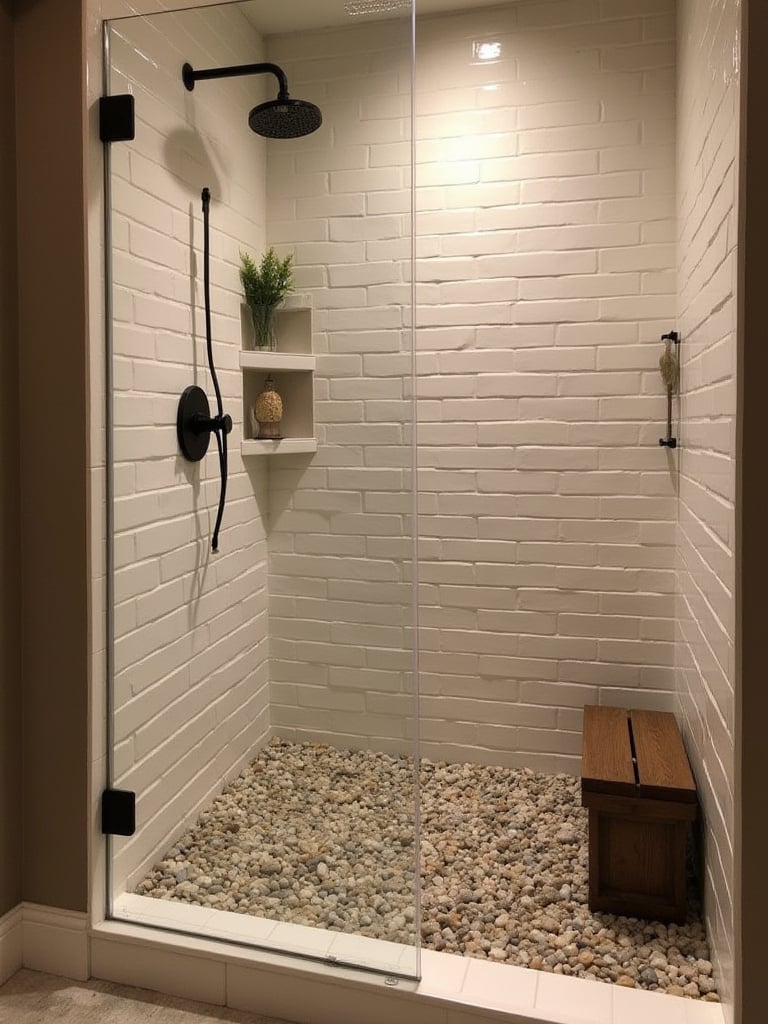
Proper waterproofing becomes absolutely critical with natural materials, requiring comprehensive membrane systems that protect both the substrate and surrounding structure. River rock installations demand meticulous attention to slope and drainage, with professional installers using specialized techniques to ensure water doesn’t pool between stones. The grouting process requires patience and skill, as the irregular surfaces of natural stone create complex joint patterns that must be completely sealed.
Consider incorporating built-in niches using matching materials for storage, and plan lighting carefully to highlight texture while providing adequate task illumination. Glass enclosures should be minimal and frameless when possible to showcase your material choices without visual interference.
“The key to successful natural material showers lies in understanding that beauty and function must work together—proper drainage and sealing are non-negotiable,” advises bathroom designer Maria Santos.
As your shower takes shape, the selection of fixtures and hardware becomes the next crucial consideration.
9. Select Distinctive Fixtures in Bronze or Matte Black Finishes
Fixture selection profoundly impacts your rustic bathroom remodel’s overall coherence and authenticity. Oil-rubbed bronze and matte black finishes provide the visual weight and sophisticated contrast necessary to ground rustic spaces, preventing them from feeling too casual or unfinished. These darker finishes complement natural wood tones beautifully while hiding water spots and fingerprints better than polished alternatives, reducing maintenance requirements in busy family bathrooms.
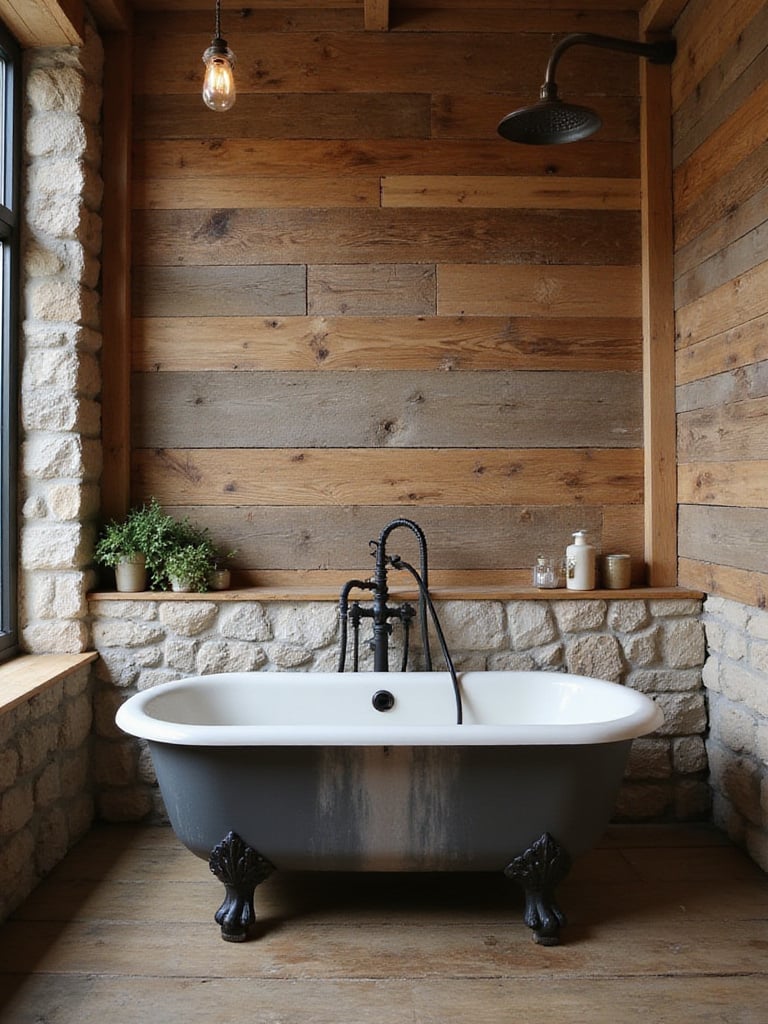
The key lies in complete coordination across all elements—faucets, showerheads, towel bars, cabinet hardware, and even door hinges should share the same finish family for maximum impact. Quality varies significantly between manufacturers, so research construction methods and warranty coverage carefully. Look for PVD (Physical Vapor Deposition) finishes on matte black fixtures for superior durability, while oil-rubbed bronze options may feature living finishes that develop character over time.
- Coordinate all metal elements including light fixtures and decorative accessories
- Research finish durability and maintenance requirements before committing
- Consider water pressure requirements for specialty showerheads and faucets
- Plan rough-in locations carefully to accommodate chosen fixture styles
The substantial visual impact of well-chosen fixtures creates perfect opportunities for complementary lighting design.
10. Illuminate with Industrial or Lantern-Style Lighting
Lighting design in your rustic bathroom remodel serves dual purposes: providing essential task illumination while reinforcing your chosen aesthetic through carefully selected fixtures. Industrial-style sconces with metal cages or Edison bulbs bring authentic factory charm, while lantern-inspired fixtures evoke cozy cabin atmospheres with their warm, diffused light. These fixtures often feature substantial construction and distinctive silhouettes that function as sculptural elements even when not illuminated.

Proper placement proves crucial for both function and safety. Vanity lighting should be positioned at eye level on either side of mirrors to minimize shadows, while general ambient lighting needs dimmer controls for versatility. All fixtures must carry appropriate IP ratings for bathroom use—damp location ratings for general areas and wet location ratings for shower zones. Consider the color temperature of your bulbs carefully, as warmer 2700K-3000K temperatures enhance wood tones and create inviting atmospheres.
Layer your lighting design with multiple sources and controls, allowing you to create different moods throughout the day. Natural light integration through skylights or larger windows can dramatically enhance the appeal of natural materials while reducing reliance on artificial illumination during daytime hours.
The interplay between your lighting choices and reflective surfaces leads naturally to mirror selection considerations.
11. Install a Statement Mirror with Distressed Wood or Metal Frames
Mirror selection offers another opportunity to reinforce your rustic bathroom remodel’s authentic character while serving essential functional needs. Distressed wood frames crafted from reclaimed barn siding or weathered fence posts bring organic warmth and textural interest, while aged metal frames in wrought iron or galvanized steel provide industrial contrast. The key lies in choosing pieces with genuine patina and character rather than artificially distressed alternatives that lack authentic appeal.

Scale and proportion require careful consideration—your mirror should relate properly to both the vanity below and the wall space available. Generally, mirrors should be 2-4 inches narrower than the vanity and positioned with their centers at eye level for optimal functionality. Custom framing allows you to incorporate materials that match other elements in your design, creating cohesive visual connections throughout the space.
Consider the mirror’s reflective qualities as well as its frame. Antique mirrors with slight imperfections or silvering variations add character, while modern mirrors provide clearer reflections for daily grooming tasks. The choice depends on whether you prioritize authentic period character or practical functionality.
“A well-chosen mirror becomes the jewelry of the bathroom—it’s often the first thing people notice and sets the tone for the entire space,” notes interior designer Sarah Mitchell.
Storage solutions provide the next opportunity to blend functionality with rustic appeal.
12. Create Open Storage with Floating Shelves and Iron Brackets
Open shelving systems using reclaimed wood planks and wrought iron brackets perfectly embody the rustic bathroom remodel philosophy of combining beauty with functionality. These installations maximize vertical space while displaying both practical items and decorative accessories, creating curated vignettes that feel lived-in rather than sterile. The contrast between warm wood and dark metal brackets provides visual interest while maintaining the authentic industrial-rustic aesthetic.
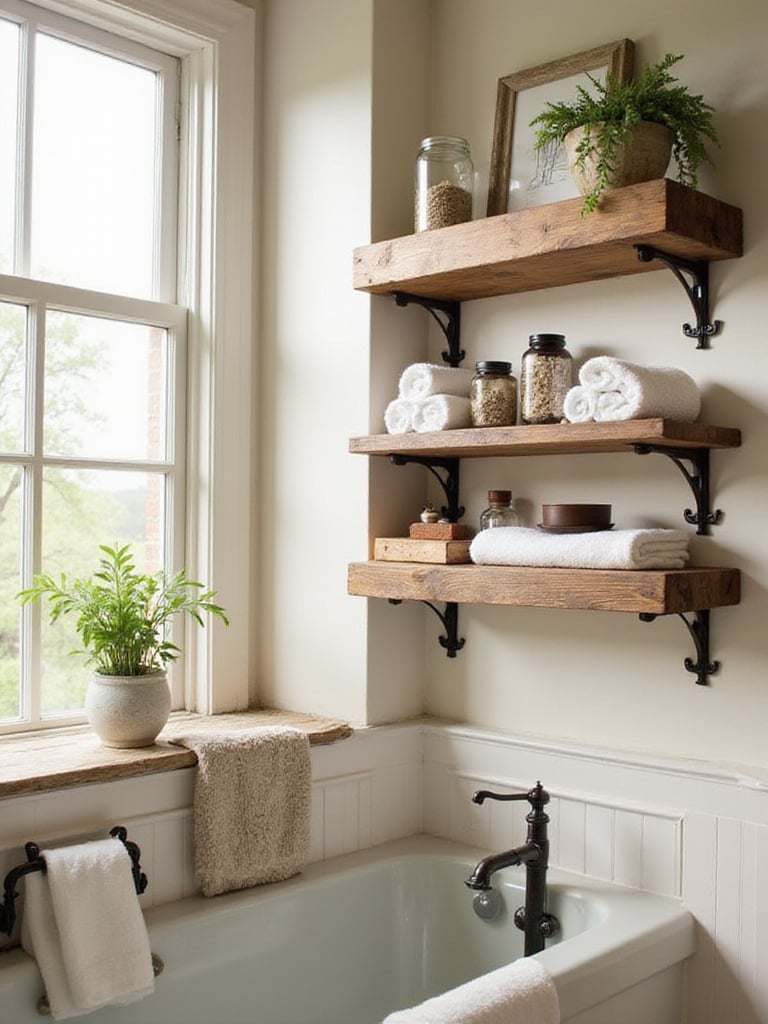
Installation requires careful attention to wall structure and weight distribution. Locate studs for secure mounting, especially when using solid wood shelves that will support towels, toiletries, and decorative objects. Consider the humidity effects on wood movement, allowing for seasonal expansion and contraction in your mounting system. The brackets themselves become decorative elements, so choose designs that complement your overall aesthetic—simple geometric forms for modern rustic spaces or ornate forged details for traditional applications.
- Plan shelf spacing to accommodate your specific storage needs and proportions
- Consider weight capacity when selecting bracket styles and mounting methods
- Group items thoughtfully mixing functional and decorative elements for visual appeal
- Leave breathing room to avoid cluttered appearances that undermine the design
Styling your shelves becomes an ongoing opportunity to refresh your bathroom’s personality through seasonal accessories and personal collections.
The foundation of comfort in any bathroom lies in thoughtfully selected textiles that soften hard surfaces.
13. Layer Earth-Toned Textiles for Warmth and Comfort
Textile selection transforms your rustic bathroom remodel from a collection of hard surfaces into a welcoming retreat through the strategic use of natural fibers and earth-inspired colors. Organic cotton towels in warm sage or terracotta, jute bath mats with interesting weaves, and linen shower curtains in oatmeal or charcoal provide essential softness while reinforcing your connection to natural materials. These elements absorb sound, add visual warmth, and create tactile experiences that make the space feel more residential than institutional.
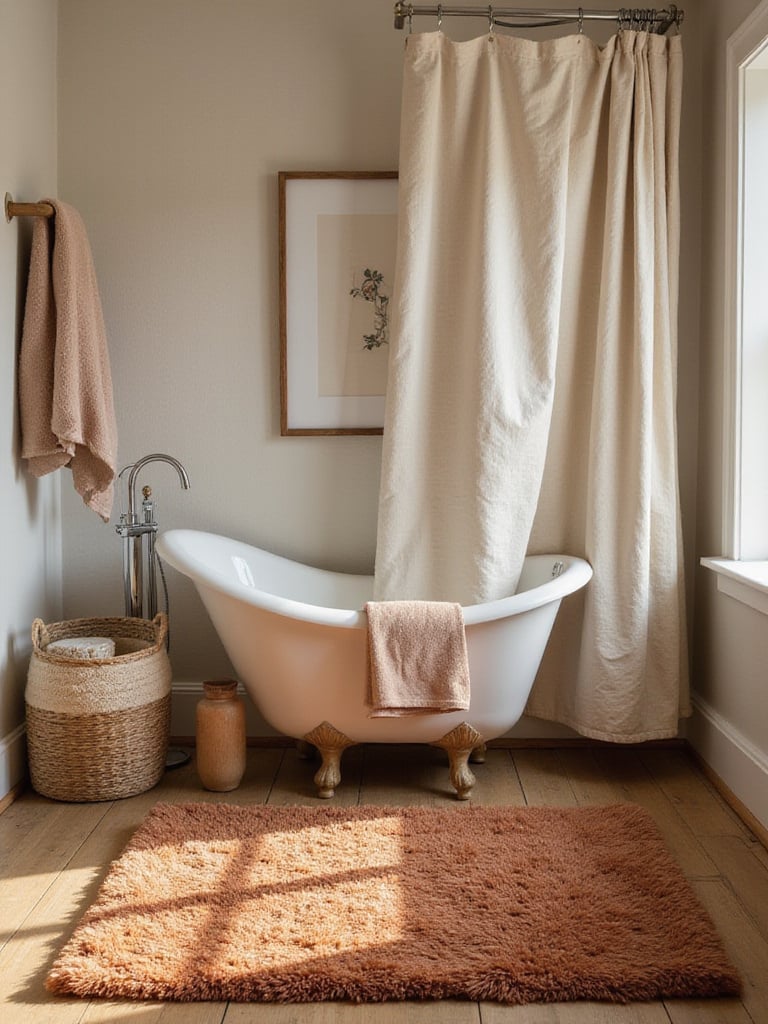
Quality matters significantly with bathroom textiles, as they must withstand frequent washing and high humidity conditions. Look for pre-shrunk fabrics, colorfast dyes, and construction methods that maintain appearance over time. Natural fibers generally perform better than synthetics in humid conditions, breathing properly and resisting odor retention. Consider having multiple sets to allow for proper drying between uses, extending the life of your investment.
Layer textures thoughtfully by combining smooth and nubby weaves, varying pile heights, and mixing complementary colors within your earth-tone palette. A chunky knit bath mat over a flat-weave rug creates visual depth, while varied towel textures add interest to open shelving displays.
The organic appeal of textiles creates perfect opportunities for introducing living elements into your rustic sanctuary.
14. Introduce Natural Greenery with Low-Maintenance Plants
Living plants complete your rustic bathroom remodel by introducing the final element of biophilic design that connects your space to the natural world. Bathroom environments with their higher humidity levels actually benefit many tropical plants, creating mini ecosystems that improve air quality while softening hard architectural elements. Snake plants, pothos, and ZZ plants thrive in low-light conditions while requiring minimal maintenance, making them perfect for busy households.
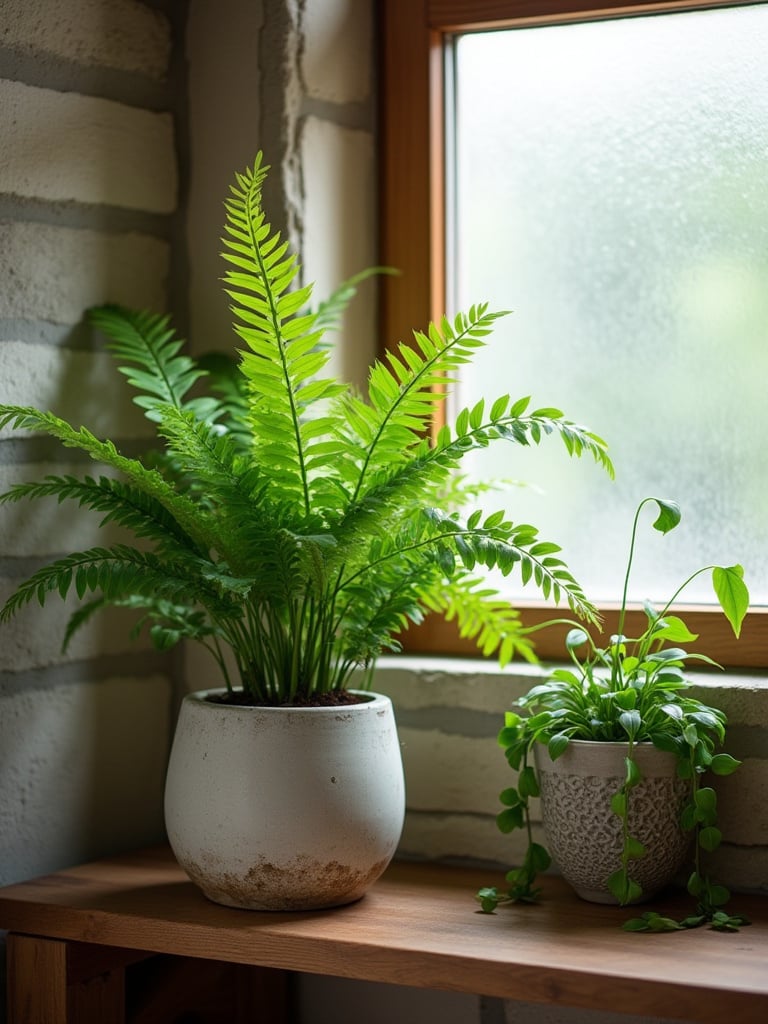
Plant selection should consider both aesthetic and practical factors. Trailing plants like pothos work beautifully on high shelves or in hanging planters, creating vertical green elements that draw the eye upward. Architectural plants like snake plants provide strong vertical lines that complement rustic materials without competing for attention. Consider the mature size of plants when planning placement, ensuring adequate space for growth without overcrowding.
- Choose planters made from natural materials like terracotta, woven baskets, or reclaimed wood
- Group plants in odd numbers for more natural, asymmetrical arrangements
- Consider maintenance access when placing plants on high shelves or in corners
- Rotate plants occasionally to ensure even growth and prevent reaching toward light sources
The living elements you introduce create perfect opportunities for incorporating found objects and vintage pieces with authentic stories.
15. Incorporate Vintage Finds and Repurposed Elements
Authentic vintage pieces and thoughtfully repurposed items add irreplaceable character to your rustic bathroom remodel, creating focal points that spark conversation while supporting sustainable design practices. Old wooden ladders become unique towel racks, galvanized metal buckets transform into planters, and antique mirrors bring history and patina that new items cannot replicate. The key lies in selecting pieces with good structural integrity that can be properly sealed for bathroom use.

Successful repurposing requires understanding both the original item’s construction and its new functional requirements. Wooden pieces need thorough cleaning, possible pest treatment, and appropriate sealing for moisture resistance. Metal items may require rust treatment and protective coatings to prevent deterioration in humid conditions. Always prioritize safety and functionality alongside aesthetic appeal—beautiful pieces that don’t perform their intended functions become decorative burdens rather than useful additions.
Source items from estate sales, architectural salvage yards, and antique shops, looking for pieces with interesting textures, appropriate scales, and good bones that can be restored rather than replaced. The hunt for perfect pieces becomes part of the creative process, often leading to unexpected discoveries that inspire new design directions.
The character that vintage elements bring to your space must be protected through proper environmental controls.
16. Ensure Adequate Ventilation to Protect Natural Materials
Proper ventilation forms the invisible foundation of your rustic bathroom remodel’s longevity, protecting your investment in natural materials from moisture damage that can destroy even the most beautiful installations. High-quality exhaust fans with appropriate CFM ratings for your space size, combined with proper ducting to exterior locations, actively remove humidity before it can penetrate wood finishes or cause stone deterioration. This preventive approach costs far less than repairing moisture damage after it occurs.
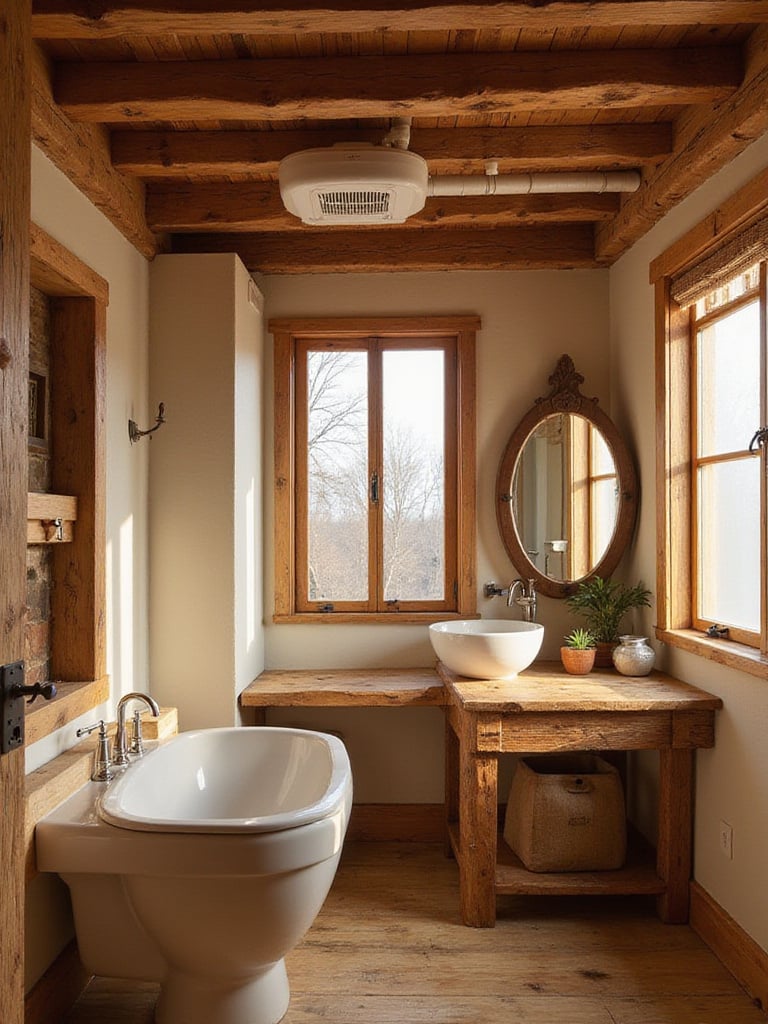
Calculate ventilation needs based on your bathroom’s cubic footage, typically requiring 1 CFM per square foot for standard bathrooms. Choose fans with low sone ratings for quiet operation and consider models with humidity sensors that activate automatically when moisture levels rise. Proper installation with rigid ducting, minimal bends, and exterior termination ensures maximum effectiveness.
- Install timers or humidity sensors to ensure adequate run times after shower use
- Inspect and clean fan housings and ducting annually for optimal performance
- Consider supplemental ventilation like operable windows for natural air circulation
- Monitor humidity levels with digital hygrometers to verify system effectiveness
“Moisture is the silent enemy of natural materials—prevention through proper ventilation is always more cost-effective than remediation after damage occurs,” emphasizes building science consultant Robert Chen.
Environmental protection creates the foundation for long-term accessibility and universal design considerations.
17. Plan for Universal Design and Aging-in-Place Features
Incorporating accessibility features into your rustic bathroom remodel ensures the space remains functional for users of all abilities while maintaining aesthetic integrity. Modern grab bars in oil-rubbed bronze or matte black finishes complement rustic hardware while providing essential safety support. Curbless showers with natural stone floors offer barrier-free access while creating spa-like experiences, and comfort-height toilets improve usability without compromising style.
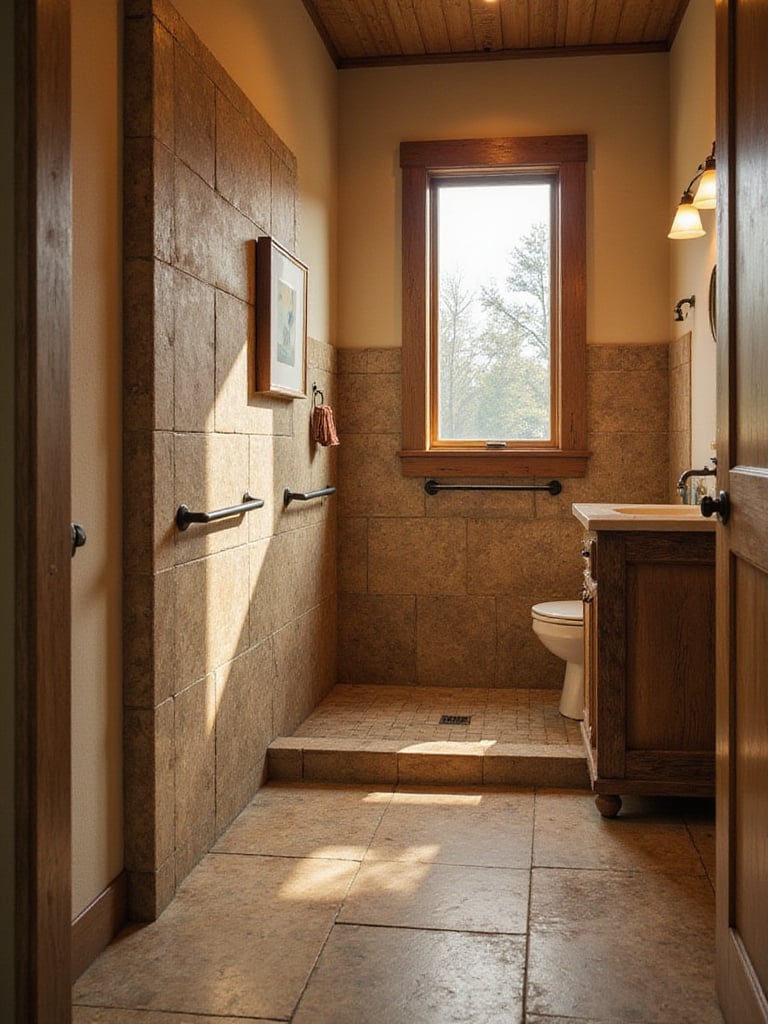
The key lies in integrating these features seamlessly into your design rather than treating them as afterthoughts. Wall-mounted vanities provide wheelchair clearance while showcasing beautiful reclaimed wood construction. Lever-style faucets in coordinating finishes offer easier operation than traditional knobs while maintaining period-appropriate aesthetics. Wide doorways and clear floor spaces accommodate mobility aids without feeling institutional.
Consider future needs as well as current requirements—blocking for potential grab bar installation costs little during construction but provides valuable flexibility for changing needs. Non-slip floor treatments can be integrated into natural stone installations, providing safety without compromising beauty.
Universal design principles benefit everyone, creating spaces that feel welcoming and functional regardless of physical capabilities.
With accessibility addressed, attention turns to the ongoing care that preserves your investment’s beauty and functionality.
18. Master Maintenance Routines for Natural Materials
Long-term success of your rustic bathroom remodel depends on understanding and implementing proper maintenance routines for natural materials. Reclaimed wood requires regular inspection of sealing integrity, with annual touch-ups in high-splash areas and complete refinishing every 3-5 years depending on use patterns. Natural stone needs periodic resealing with penetrating products that protect against stains while preserving the material’s natural appearance and texture.
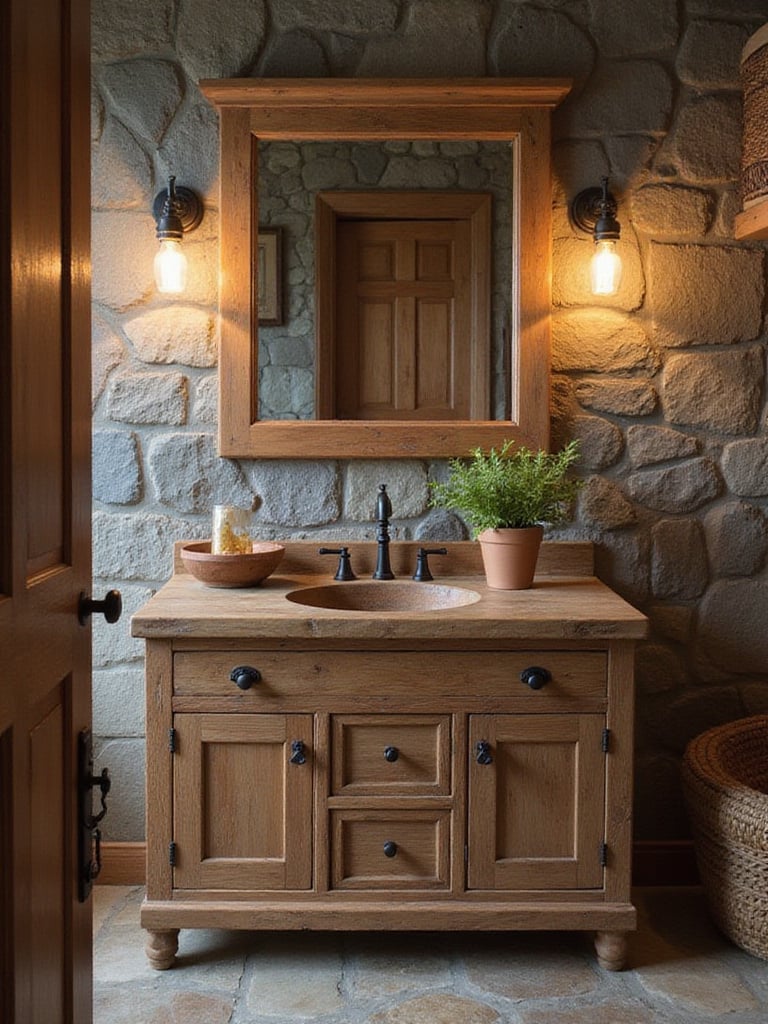
Daily maintenance practices prove as important as periodic treatments. Wiping down surfaces after use, addressing spills immediately, and ensuring adequate ventilation prevent most moisture-related problems before they begin. Use pH-neutral cleaners specifically formulated for natural materials, avoiding harsh chemicals that can damage finishes or etch stone surfaces.
- Keep maintenance supplies readily available to encourage consistent care
- Document maintenance schedules to ensure timely resealing and refinishing
- Address problems immediately before they become expensive repairs
- Work with qualified professionals for major restoration or refinishing projects
“The most beautiful natural materials require the most thoughtful care—but the reward is a space that becomes more beautiful with age rather than showing wear,” notes restoration specialist Michael Torres.
Proper maintenance ensures your rustic retreat continues providing daily joy and relaxation for decades to come.
Conclusion
Creating your dream rustic bathroom remodel represents more than a simple renovation—it’s an investment in daily wellness and long-term home value through spaces that celebrate authentic materials and timeless design principles. From the foundational decisions of defining your aesthetic vision and establishing realistic budgets to the finishing touches of vintage accessories and proper maintenance routines, each element contributes to a cohesive retreat that feels both grounding and inspiring.
The journey requires patience, planning, and attention to detail, but the rewards extend far beyond mere aesthetics. Natural materials like reclaimed wood and stone create sensory experiences that connect us to nature’s rhythms, while thoughtful design choices ensure functionality that adapts to changing needs over time. The key lies in balancing authentic character with modern performance, creating spaces that honor traditional craftsmanship while meeting contemporary lifestyle demands.
Your rustic bathroom remodel awaits, ready to transform daily routines into moments of peaceful retreat. Begin with careful planning, invest in quality materials and professional installation, and commit to the ongoing care that preserves natural beauty. The result will be a timeless sanctuary that grows more beautiful with age, providing decades of comfort, functionality, and authentic charm that reflects your personal style and values.
